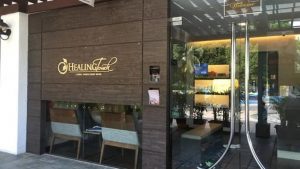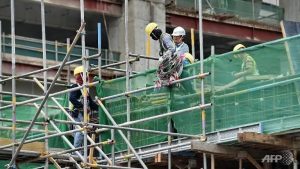
All nine Healing Touch spa outlets have been shut since April.
SINGAPORE: The owner of spa chain Healing Touch is anxious about reopening his business when Singapore enters Phase 2 of its recovery journey after COVID-19 “circuit breaker” restrictions.
On one hand, Mr Joshua Lung, who also owns Aesteem Aesthetic Clinic, is looking forward to receiving customers again after being closed since early April.
On the other, he is unsure what kind of safety measures health and wellness establishments will be required to implement, and if those restrictions will hinder the spa experience his customers are accustomed to.
All 10 of Mr Lung’s Healing Touch and Aesteem outlets have been closed since the beginning of April, as massage and spa services are not considered an essential service under COVID-19 restrictions and only specific aesthetic treatments are allowed.
With zero revenue, Mr Lung has been able to tide through only because of relief measures from the Government, including rental rebates and the Jobs Support Scheme (JSS), which has enabled him to retain and pay his 35 full-time employees for the past two months.
News that personal health and wellness services will be allowed to resume in Phase 2 of the post-circuit breaker opening has come as a relief.
But his worries have not fully disappeared.
“My main concern now is whether safety will be excessively restrictive until it discourages customers from returning as it significantly impacts the experience,” said Mr Lung.
For example, time limits on treatments, perhaps of an hour, would substantially reduce his revenue, he said.
Mr Lung also expects that tourists – who make up 15 per cent of his clientele – are likely to continue to avoid travelling, affecting his sales for the next 12 months.
With the challenges ahead, Mr Lung said he expects post-circuit breaker revenue to decline at least 20 per cent from pre-COVID-19 days – which is as optimistic an outlook as he can imagine.

Aesteem Aesthetic Clinic, which was allowed to provide only specific treatments, has not resumed operations because it would be more expensive to open up for limited services than to remain closed.
DIPPING INTO SAVINGS
Small- and medium-size enterprises (SMEs) have come under severe pressure during the coronavirus pandemic. Many were forced to close or restrict their services during the circuit breaker, seeing their bottom line hurt badly in the process.
And even as Singapore gradually eases restrictions, there are no certainties that business will recover to pre-COVID-19 levels in the near future, business owners and analysts told.
Officially defined as enterprises with an annual turnover of no more than S$100 million and up to 200 workers, SMEs are likely to bear the brunt of the economic downturn due to their liquidity constraints, said analysts.
With SMEs making up 99 per cent of all of Singapore’s companies, 72 per cent of its workers and 45 per cent of the nominal value added to the economy last year, the challenges they face could have implications for the wider economy.
There are two main reasons why small businesses will struggle more during this pandemic-induced fallout, said NUS Business School’s Associate Professor Nitin Pangarkar.
First, small businesses tend to have weaker balance sheets and second, they are typically not as diversified as larger firms.
“So if they are dependent on that one thing, and that one thing – one (type of) customer, one business or one geography like Singapore – gets affected, then they get badly affected,” he said.
In the case of a worldwide pandemic, SMEs with operations beyond Singapore are also suffering.
Pink Parlour’s president Derrick Seeto co-runs 15 waxing salons across the region, but all of them have had to close because of lockdowns in those countries.
With one stream of revenue cut off, Mr Seeto upgraded Pink Parlour’s e-commerce platform. Despite the efforts, online sales have managed to account only for one-tenth of pre-COVID-19 revenue, said Mr Seeto.
As a result, the company had to dip into reserves meant for acquisitions to stay afloat.
While business is slowly returning and customers make advance bookings as countries ease their lockdowns, it will take at least six months for the business to recoup the money, Mr Seeto said.
“I wouldn’t say I’m in a happy position,” he said.
WEAK SENTIMENT
Recent polls have highlighted weak sentiment among small business operators.
A study released in May by business data firm Experian showed that 47 per cent of SMEs expect sales to decline this year.
The study, which polled 200 local SMEs, also showed that only 10 per cent of SMEs expect to see at least 0.5 per cent growth in sales compared to 2019.
Meanwhile, the remaining 43 per cent expect to see anything between 0 to 0.5 per cent growth in sales.
A separate survey by the Singapore Business Federation (SBF) and Experian in April that polled 3,000 SMEs showed that their business sentiment was at an all-time low.
The SBF-Experian SME Index for April to September registered an overall reading of 48.3, the lowest reading since the index was launched in 2009.
The survey was conducted in January and February this year. Given the escalating impact of COVID-19, sentiment is likely to have fallen further, SBF said in its press release.
JOBS ON THE LINE
With COVID-19 causing an existential blow on small businesses in Singapore, jobs are likely to be lost.
Officials and market watchers have warned that Singapore’s resident unemployment rate, which stood at 3.3 per cent in the first quarter, will rise.
In the first quarter, 3,000 workers were retrenched, up from 2,670 in the previous three months.
Official data released by the Ministry of Manpower does not provide information on how many of the layoffs were from small businesses, but the US labour report could offer some insight, said Maybank’s senior economist Chua Hak Bin.
A paper released by the American National Bureau of Economic Research found that between February and April this year, US businesses with fewer than 50 employees saw employment declines of more than 25 per cent, while those with more than 100 employees saw declines of 15 to 20 per cent.
“We expect Singapore’s labour market to mirror some of these patterns,” said Dr Chua, noting that the majority of firms in the hardest-hit sectors such as food and beverage and entertainment are SMEs.
He predicts that Singapore could see between 150,000 to 200,000 job losses this year.
Restaurant group Dandy Collection, which runs Neon Pigeon, Fat Prince and Summerlong, has retrenched about 25 per cent of its staff strength, according to head of operations Michael Pekarsky.
The group could not afford to keep all its employees and had to let go of 15 people from its 60-strong team after sales took a nosedive, said Mr Pekarsky.
Since April, sales across its three restaurants have fallen by between 75 and 85 per cent.
The company tried to reduce its costs by negotiating for lower fees from its suppliers and tapping on government subsidies, but was still unable to avoid the retrenchments, said Mr Pekarsky.
Such layoffs are inevitable, said industry insiders.
“If you look at your typical business unit, if you know you are not going to get back to 50, 60 per cent of your old revenue, your employment may not come down by 50 per cent because there is JSS support but you still need to cut cost,” said Association of Small and Medium Enterprises president Kurt Wee.
“It’s not unrealistic to say they will look at cutting headcount by 20 per cent … which may or may not need to be in the form of employment numbers. It may mean wage cuts, cost reductions – 20, 25 per cent (in) labour cost cuts is realistic to expect,” he added.
Earlier this month, Senior Minister and chair of the National Jobs Council Tharman Shanmugaratnam also said that many people are at risk of losing their jobs because of the pandemic.
“We have to be realistic. The sheer uncertainty facing the world – no one can tell how long COVID-19 will last – will mean that we will have far fewer new job openings than jobs being lost – over the next year, and beyond that if we are unlucky,” he wrote in a Facebook post earlier this month.
CLOSURES AND CONSOLIDATIONS
Alongside retrenchments, Singapore could see more businesses disappear.
Last week, Senior Minister of State for Trade and Industry Chee Hong Tat said in Parliament that while the number of companies that closed in April remained stable, business cessation could see an “uptick” in the coming months as the COVID-19 pandemic continues to put a severe strain on the Singapore economy.
About 3,800 companies closed down in April, comparable to the average of 3,700 recorded in the same month over the past five years.
The formation of new businesses will remain subdued for the same reason, Mr Chee added.
About 3,800 business entities were set up in April, nearly a third lower than the average of 5,500 seen in the same period between 2015 and 2019.
Pointing to the construction industry, the Association of Small and Medium Enterprises’ Mr Wee said that customers might see prices go up in the short-term as firms consolidate.
Some of them may struggle to comply with the safe management requirements they have to fulfil before they can start work, even with the government support to pay for the expenses, he said.
“When they can’t operate, means they can’t build. They can’t build means they carry cost,” said Mr Wee. “We expect quite a lot of players to fold. And when players fold it means there will be some price consolidation and prices will go up.”

File photo of a construction site in Singapore.
Companies related to the hospitality trade – aviation, tourism, nightlife – will also be “terribly affected”, said Mr Wee.
He expects more firms to close in the next three to four months, but said that it is not necessarily unhealthy, as the downturn weeds out unsustainable businesses.
And even if some businesses close, they may reappear in a different form or shape in the future.
“One of the good things of SMEs is they are really entrepreneurial and dynamic. So even if a lot of the current crop die … when things become normal then a new crop of SMEs will come up,” Assoc Prof Nitin said.
ADAPTING, BUT FUTURE REMAINS UNPREDICTABLE
For now, small businesses are learning to adjust to the “new normal” – a life of hygiene measures and social distancing requirements.
Healing Touch’s Mr Lung has prepared a set of safety protocols – such as staggered appointments and protective gear for employees – that will be put in place once the Government gives the green light for health and wellness services to resume.
At Pink Parlour, Mr Seeto has stocked his warehouse with UV disinfection lamps, air purifiers, masks, visors and sanitisers.
Restaurant operators have gotten more creative with their menus as well. Both Mr Pekarsky’s team and Restaurant Ibid’s chef-owner Woo Wai Leong have carved a menu that fits a delivery and takeaway mode that is more sandwiches and set meals than elaborate entrees. They have also changed their menus a few times since April to keep their offerings fresh.
With the office crowd trickling back, Dandy Collection recently launched lunch promotions, and is reaching out to corporates to cater lunches from his restaurants.
“We’re all struggling. What we’ve got to do is to put out something new and keep our guests engaged,” Mr Perkarsky said.
Despite their efforts, none of the business operators expect sales to recover until, at the soonest, the end of the year.
For Restaurant Ibid’s Mr Woo, getting through the circuit breaker might have been the easier part. Orders streamed in – although it slowed after week three – because of the novelty of ordering from new restaurants, he said.
The game plan was also straightforward during those two months, he said, adding that it was possible to study what restaurants in other countries, where lockdowns had preceded Singapore’s, had done.
“Going into post-lockdown, there has been no unified response in other countries,” Mr Woo said. “We don’t know what this ‘new norm’ in dining is.”
“Will it be safe enough to open in Phase 2? What kind of PPE do we need?” are some of the questions that remained unanswered, he said.
While there will be guidance from the authorities, concerns remain as to customer-centric services will be able to carry out hospitality.
“Given that we are in human, front-facing, experiential industry, how do we convey that same level of hospitality with a visor and a mask?,” said Mr Woo.
The circuit breaker has also fired up a new generation of home cooks and bakers that could threaten the restaurant industry’s survival.
“Everyone can make sourdough now. Everyone can make milk buns. What’s going to happen to eating out?”
Mr Woo has been lucky so far. His business is still able to afford its overheads and has not had to let go of anyone, although he says it could be because he stays open every day of the week, and has a small team of just six employees.
But what happens next, he admits, is uncertain and scary.
“In all honesty, I’m just going day by day. I don’t want to think too much about the future,” Mr Woo said. “To say I’m worried is an understatement.”



